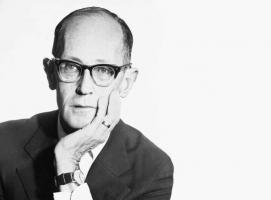Romanticism: characteristics of art and literature
Romanticism is an artistic and literary movement that emerged in the transition from the 18th century to the 19th century in England, Germany and France, and from there it spread to the entire western world, including the continent American.
The romantic movement is based on the expression of subjectivity and creative freedom as a reaction to the rationalism of neoclassical art, movement that, in addition to being rigorously academic, had entered a standardized phase that earned it the reputation of cold and servile to power political. Says historian E. Gombrich that during romanticism:
For the first time, perhaps, it became true that art was a perfect medium for expressing individual feelings; provided, of course, that the artist possessed that individual feeling to which to give expression.
This interest in creative freedom and individual expression made romanticism an extremely diverse movement. There were revolutionary and reactionary artists; There were also artists who were evasive of reality, other promoters of bourgeois values and others anti-bourgeois. What could be pointed out as common traits? Eric Hobsbawm says that the bout of the middle ground. To better understand this, let's get to know the context, values, and characteristics of romanticism.
Historical context and origin of romanticism

Culturally, the eighteenth century was marked by the Enlightenment, which advocated the triumph of reason on fanaticism, freedom of thought and faith in progress as a new sense of story. Religion lost its public influence and was confined to the private sphere. The industrial revolution, which was running in parallel, consolidated the bourgeoisie as the ruling class and formed an emerging middle class.
The Enlightenment was expressed through neoclassic art. With neoclassicism, "isms" as such began, that is, movements with a program and deliberate awareness of style. But there were still barriers to individual freedom and contradictions, so it didn't take long for a reaction to form.
The new changes aroused distrust in the face of excessive "rationalism" that, ironically, justified many intolerant practices; He looked longingly at the times of faith and felt a certain distrust towards the new social sectors without tradition.
The impact of the "good savage"
In 1755, Jean-Jacques Rousseau published Discourse on the origin and foundations of inequality between men, where he refuted the work Leviathan by Thomas Hobbes. Hobbes justified enlightened despotism to guarantee reason and social order, since he understood that the individual tends to corruption by nature.
Rousseau proposed the opposite thesis: that human beings are good by nature and that society corrupts them. The American aborigines, who were said to live in harmony with nature, were referred to by Rousseau as an exemplary model. Thus arose the thesis of the "good savage". The idea was so scandalous that it earned him enmity with Voltaire and was considered heretical by the Church. Still, no one could stop the revolutionary contagion from him.
The appearance of Sturm und Drang
Between 1767 and 1785 a Germanic movement arose called Sturm und Drang ("Storm and Momentum"), driven by Johann Georg Hamann, Johann Gottfried von Herder and Johann Wolfgang von Goethe. This movement rejected the rationalism and rigor of neoclassical art and became the antecedent and impulse of romanticism. The movement had been influenced by Roussonian thought and awakened the germ of dissatisfaction with the state of affairs.
Art as a vocation
Romanticism, prompted in part by the Sturm und DrangIt also revealed a criticism, but this stemmed from a deep distrust of the known world, that world of progress and growing massification.
The academies had constrained artistic creativity and the art of the late eighteenth century had ceased to be revolutionary to be predictable and servile. The romantics believed that art was meant to express not only the opinion but the sensitivity of the artist. The idea of art as a vocation was born, which freed the artist from the obligations of the relationship with the client / employer.
See also: Neoclassicism: Characteristics of Neoclassical Literature and Art.
Characteristics of romanticism
Let's identify some common traits in terms of romantic values, conception, purpose, themes, and sources of inspiration.
Imagination vs. intelligence
From the point of view of the romantics, the exercise of the imagination was comparable to the cognitive thinking of philosophy. Therefore, they revalued the role of imagination in art, a determining aspect for the entire romantic agenda in any of the artistic disciplines.
Subjectivity vs. objectivity
The romantic movement sought the exaltation of subjectivity, feelings and states of mind over objectivity and rationalism. Romantic art wanted the expression of subjectivity to prevail over any other element. In this sense, the subjective and emotional universe became the center of interest for artists. He especially dominated the attention on the intense and mystical feelings. Fear, passion, madness and loneliness were some of the themes that most occupied the creators.
The sublime vs. classic beauty
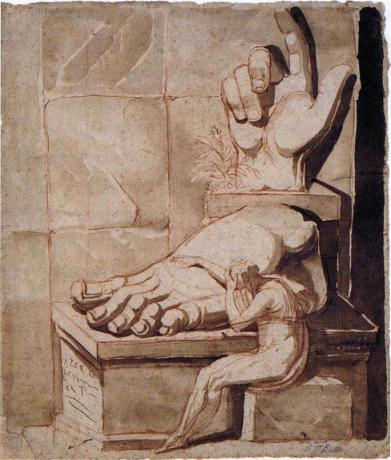
Classical beauty as the supreme aesthetic reference gives way to the notion of the sublime. The idea of the sublime would be in the perception of the absolute greatness of the contemplated, that incomparable that not only pleases, but also it moves, overwhelms and disturbs, due to the inadequacy of what is observed with any expectation rationally configured in the mind of who contemplate.
Nationalism
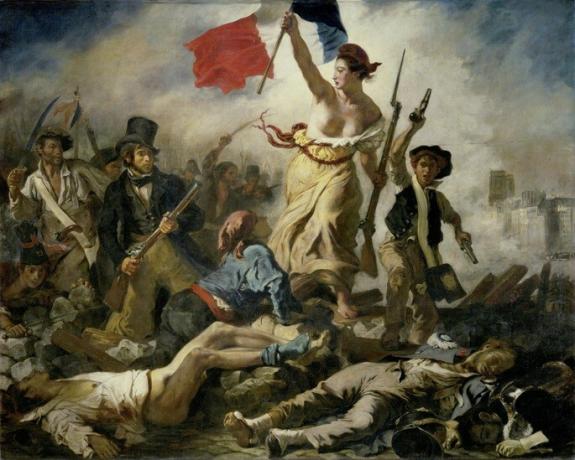
In romanticism, nationalism was the collective expression of the search for identity, which referred not only to the individual, but to its origin, its inheritance, its sense of belonging, increasingly precarious as it is a time of historical changes transcendental. That is to say, romanticism not only sought the "me" but the "we" that justified it. For this reason, he frequently turned to popular culture as a source of inspiration.
Nationalism had awakened in Europe since Montesquieu, in the context of the Enlightenment, defined the theoretical bases of the nation in the 18th century. In fact, nationalism was a value shared by neoclassicists, but romanticism conferred a new meaning by linking it not only to a political but an ontological principle: the "being national".
This value acquired great belligerence in romanticism when Napoleon, the revolutionary symbol of the secular state, demonstrated sooner rather than later his desire to establish a European empire. The reaction was immediate. The artists of the romantic transition immediately turned their backs on the supposed leader of modern times. A paradigmatic example is Beethoven, who had dedicated the Heroic Symphony Napoleon and, seeing him advance against the German people, he erased the dedication.
See also: Analysis and meaning of the table Freedom guiding the people by Eugène Delacroix.
Nostalgia for the past
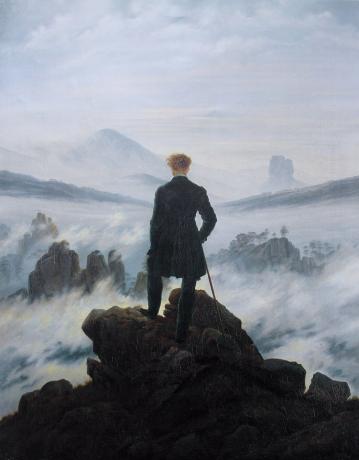
The known world trembles under the feet of the romantic artist. On the one hand, he is moved by the new political values of freedom, equality and fraternity. On the other hand, he is haunted by the progressive and dramatic changes of the industrial revolution in the making. This modernizing movement makes him feel that the unity between man and nature has been lost and that he must return to the times where that "was possible." To do this, he uses three sources, each of which express different tendencies within romanticism:
The Middle Ages
It especially attracted the romanticism of reaction. The paths were two, essentially:
- Inspiration in medieval sacred art: some romantics saw in the religiosity of the Middle Ages, and especially in the Gothic art, a symbol of faith and national identity. From this spirit arose the interest to complete the Cologne Cathedral, which had been started in 1248 and was only completed in the 19th century.
- The medieval wonder: monsters, mythical creatures, legends and mythologies discarded by enlightened rationalism (eg Norse mythology) returned from the hand of the romantics. That is why the study of comparative mythology was born in romanticism.
Primitive man, the exotic, and popular culture
A fairly widespread line was the one that was inspired by national popular culture. Along with this line, the one that the “exotic” cultures valued and the one that valued the so-called “primitive” cultures, that is, indigenous cultures of the American nations, is also recognized. This line was influenced by Roussonian thought.
The French Revolution and Libertarian History in General
The French Revolution was welcomed by the romantic defenders of freedom, equality and fraternity, interpreted from nationalism.
Individualism
Romantic individualism seeks the expression of the self. It is not about the contemporary sense of individualism, but about the recognition of individual identity, which allows the subject to perceive himself himself as unique, as different, but at the same time as part of a collective that also enjoys particular traits that distinguish it from others.
In some cases related to art, individualism implied a challenge to the public through resources such as artistic improvisation (particularly in music), which allowed social distinction at a time when culture and consumer goods were progressively "democratizing".
Idea of tormented and misunderstood genius
Along with individualism, the idea of the romantic genius also appears. He is not the genius of the Renaissance, who stands out for his impeccable handling of technique within the artistic convention of his time. In addition to his technical talents, the romantic genius is touched by imagination, originality, virtuosity, and also by a tormented life. The man of romanticism is a misunderstood and tormented genius.
Rediscovery of nature
Landscape was already highly explored in previous generations as a genre. However, it was considered a minor genre until romanticism gave it a new character. For romantic artists, nature was a metaphor for the inner world of the individual or a true source of inspiration and beauty, not merely the context of pastoral scenes. A volcano, for example, could be interpreted as a metaphor for passion, or an icy landscape as a metaphor for loneliness or failure. Romantics often preferred the wilder or more mysterious aspect of the landscape.
Creative freedom (liberation from academic rules)
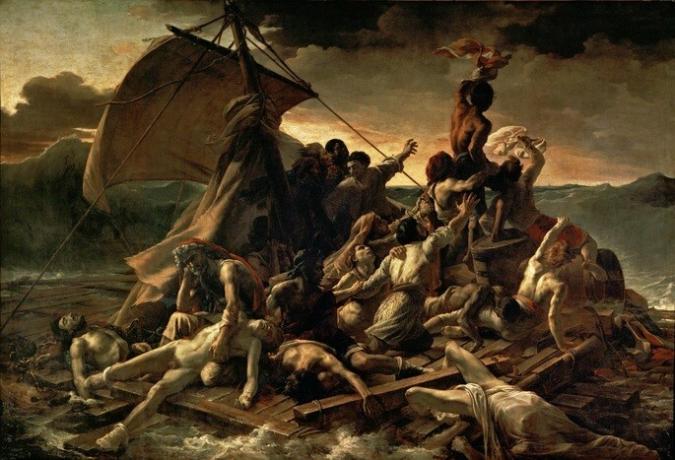
Romantic art proposes liberation from the rigid rules of academic art and, in particular, neoclassicism. It is not a question of an absolute negation of technique, but of its subordination to individual expression.
Visionary or dreamlike character
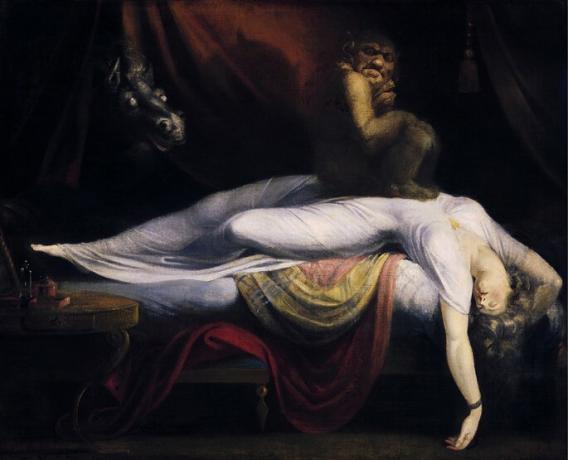
Romantic art brings to light the interest in dream affairs, that is, related to dreams and fantasies, where the imagination is freed from rational subjection. The allusion to the world of nightmares, phantasmagorias and daydreams is not surprising.
Topics

From all the aforementioned, the themes of romanticism emerge, which cover a register as diverse as the treatment of:
- Nationalist themes:
- Pictures of national or revolutionary history;
- Revolutionary values, especially of a nationalist type;
- Fallen heroes.
- Literary themes:
- Inspiration and representation of scenes taken from the national literature of any period in history, in rejection of the themes of Classical Antiquity.
- Popular Topics:
- Traditions and customs;
- Legends;
- National mythologies (wide dissemination of Norse mythology).
- Exotic themes:
- Orientalism;
- Aboriginal universe.
- Existential concerns and feelings:
- Melancholia;
- Melodrama;
- Passions (love, passion, anger, etc);
- Death, especially suicide.
- Scenery.
Characteristics of romantic literature
- Literature, like music, was perceived as an art of public interest as it adjoined the values of growing nationalism;
- Defense of the cultural supremacy of the vernacular through the national literature;
- Incorporation of popular heritage to the themes and styles of literature as a challenge to aristocratic and cosmopolitan culture;
- Appearance and development of romantic irony;
- Valuation of popular lyric poetry;
- Presence of the feminine spirit;
- Liberation of poetry from neoclassical canons;
- Appearance of the article of customs;
- Appearance of the historical novel and the Gothic novel;
- Development of the novel by installments (serial novel).
Among the representative writers of romanticism we can mention the following:
- Johann Wolfgang von Goethe (1749-1832). Representative works: Young Werther's Misadventures (fiction); Color theory.
- Friedrich Schiller (1759-1805). Representative works: William Tell, Ode to joy.
- Novalis (1772-1801). Representative works: The Disciples in Sais, The Hymns to the Night, The Spiritual Songs.
- Lord Byron (1788-1824). Representative works: The pilgrimages of Childe Harold, Cain.
- John Keats (1795-1821). Representative works: Ode on a Greek Urn, Hyperion, Lamia and other poems.
- Mary Shelley London (1797-1851). Representative works: Frankenstein, The Last Man.
- Victor Hugo (1802 - 1885). Representative works: Les miserables, Our Lady of Paris.
- Alexander Dumas (1802 - 1870). Representative works: The Three Musketeers, The Count of Monte Cristo.
- Edgar Allan Poe (1809-1849). Representative works: The Raven, The Murders of Morque Street, The House of Usher, The Black Cat.
- José de Espronceda (1808 - 1842). Representative works: Song of the pirate, The student of Salamanca.
- Jorge Isaacs (1837 - 1895). Representative work: Mary.
You may also like: Poem The song of the pirate by José de Espronceda
Characteristics of the music of romanticism
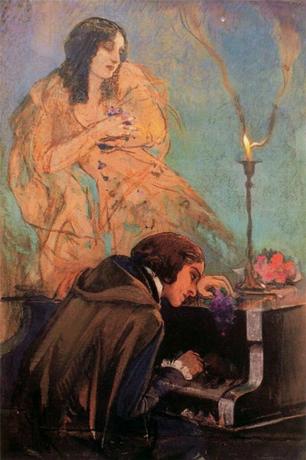
- Music reached the leading role as public art.
- Perception of music as a political manifesto and revolutionary weapon.
- New boom in the relationship between music and literature, which led to the flourishing of the lied as a musical genre.
- Valorization of the vernacular as a musical text:
- Development of operas in the vernacular;
- Extraordinary development of the song genre with traditional, popular and national poetry.
- Incorporation of themes and forms of popular heritage and national interest.
- Promotion of opera as an art of public interest.
- Greater complexity of rhythms and melodic lines.
- Development of new harmonic resources other than classical harmony.
- Search for contrasts and exploration of nuances at its best.
- Appearance of the symphonic poem.
- Extraordinary development of piano music, an instrument whose origin dates back to the previous period, but it is in romanticism that all its expressive possibilities are explored.
- Appearance of the following instruments that are added to the orchestra: contrabassoon, English horn, tuba and saxophone.
- Genres for improvisation as a genius distinction resource.
Among the most representative musicians of romanticism we can mention the following:
- Ludwig van Beethoven (1770-1827). Representative works: The Fifth Symphony, The Ninth Symphony.
- Franz Schubert (1797-1828). Representative works: Das Dreimäderlhaus, Ave Maria, Der Erlkonig (Lied).
- Robert Schumann (1810-1856). Representative works: Fantasy in C, Kreisleriana op. 16, Frauenliebe und leben (Love and life of a woman), Dichterliebe (Love and life of a poet).
- Fréderic Chopin (1810-1849). Representative works: Nocturnos Op. 9, Polonaise Op 53.
- Richard Wagner (1813-1883). Representative works: The Ring of the Nibelung, Lohengrin, Parsifal, Siegfried, Tristan and Isolde.
- Johannes Brahms (1833-1897). Representative works: Hungarian Dances, Liebeslieder Waltzes Op. 52.
Characteristics of romantic painting

- Predominance of color over drawing;
- Valuation of light as an expressive element;
- Avoidance of clarity and definition;
- Influence of baroque art, especially in French romanticism;
- Strokes and textures exposed for expressive purposes;
- Dynamic compositions, often variegated;
- Release of the rules;
- Release of the order and, therefore, of individual expression;
- Most used techniques: oil painting, watercolor, engravings and lithographs.
Representatives of romantic painting
- William Blake (1757-1827). Representative works: The old man of the days; The great red dragon and the woman clothed with the sun.
- Caspar David Friedrich (1774-1840). Representative works: The walker on the sea; Monk on the seashore; Abbey in the oak grove.
- Johann Heinrich Füssli (1741-1825). Representative works: Oath in the Rütli; The nightmare.
- William Turner (1775-1851). Representative works: The "Daredevil" towed to its last berth for scrapping; The battle of Trafalgar; Ulysses mocking Polyphemus.
- Eugene Delacroix (1798-1863). Representative works: Freedom guiding the people; Dante's boat.
- Théodore Géricault (1791-1824). Representative works: The raft of the Medusa; Hunter Officer Charging.
- Francisco de Goya y Lucientes, transitional painter (1746-1828). Representative works: The executions of May 3; Saturn devouring his children, The dreams of reason produce monsters.
- Leonardo Alenza (1807-1845). Representative works: Satires of Romantic Suicide, Viaticum.
Architecture during romanticism
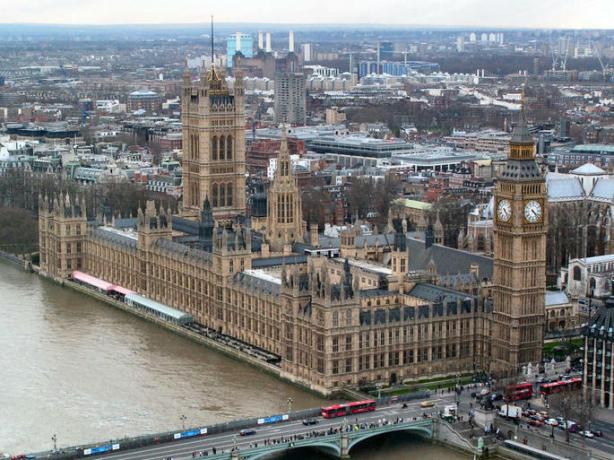
There was no proper "romantic" architectural style. The dominant trend in the early part of the nineteenth century was the architectural historicism, most of the time determined by the function of the building or by the history of the place.
This "historicism" had its beginning in the neoclassical movement, which resorted to styles such as neo-Greek or neo-Roman for public order buildings. Nostalgia for the past dominated.
For the design of religious buildings in the 19th century, architects used to resort to the forms in force during the splendor of Christianity. For example, Neo-Byzantine, Neo-Romanesque, and Neo-Gothic. Neo-Baroque, Neo-Mudejar, etc. styles were also used. Of all these styles they preserved the formal aspects, with materials and construction techniques provided by the era of the industrial revolution.


